
Searching for News: The Flint water crisis
During the long saga of the water crisis in Flint, Michigan – an ongoing, multilayered disaster that exposed about 100,000 residents to harmful contaminants and lead and left them even as of early 2017 advised to drink filtered or bottled water – local and regional audiences used online search engines as a way to both follow the news and understand its impact on public and personal health.
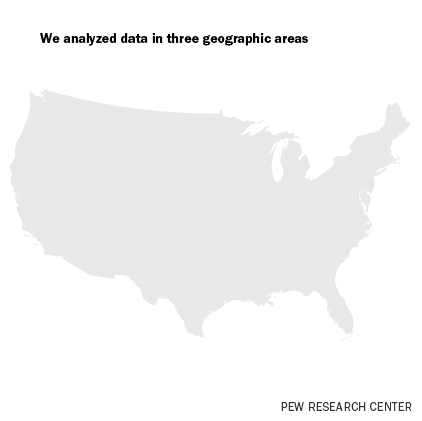
A new Pew Research Center study, based on anonymized Google search data from Jan. 5, 2014, through July 2, 2016, delves into the kinds of searches that were most prevalent as a proxy for public interest, concerns and intentions. The study also tracks the way search activity ebbed and flowed alongside real world events and their associated news coverage. The study begins in 2014, when officials switched the source of municipal drinking water from the Detroit city water system to the Flint River. The study period covers ensuing events that included bacteria-related “boil water” advisories, studies showing elevated lead levels in children’s blood and tap water samples, government-issued lead warnings, bottled-water distribution, declarations of emergency, the filing of criminal charges, a Democratic presidential candidate debate in Flint and a visit to the city by President Barack Obama.
The data, based on nearly 2,700 different search terms associated with the crisis, reveal that residents of Flint were searching for information about their water before the government recognized the contamination and before local and regional news media coverage intensified beyond a handful of stories related to the initial switch of the water supply. And, while news was the first type of information people searched for, questions about personal and public health implications soon came to the forefront. The politics of the water crisis – which involved the governor of Michigan, the city of Flint and several agencies – did not resonate as a local search topic until Obama reacted, when the story spread nationally.
While the case study focuses on one particular news event, the overarching goals are larger: to begin exploring what aggregated search behavior can tell us about how news spreads in our increasingly fractured information environment, as well as about how the public’s focus shifts over the course of a developing news story. To achieve these goals, researchers needed to focus on a specific story with many unique keywords and a strong geographic element, traits that make it easier to track search activity. The Flint case not only meets these criteria but also epitomizes a crisis that had an impact at the personal, community and political level, and – as it developed over more than two years – grew from a local story to a national one.
Researchers collected data from the Google Health Application Program Interface (API), to which the Center gained special access for this project. Using a multistep process, researchers identified relevant search terms, ranging from specific searches related to Flint such as “Flint water EPA” to more practical issues such as “why is my water brown.” These individual queries were then grouped into five broad categories – News and Media, Politics and Government, Public Health and Environment, Personal Health and Household, and Chemical and Biological Contaminants – representing the primary aspects of the story that preoccupied local, state and national residents, as suggested by their search habits. The analysis was conducted across three different geographic areas – the Flint DMA, the whole state of Michigan and the entire U.S.

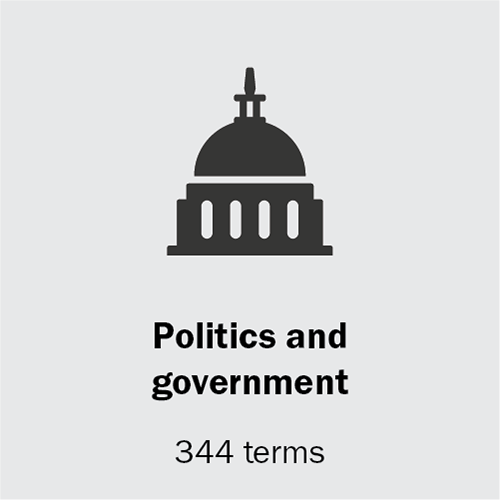
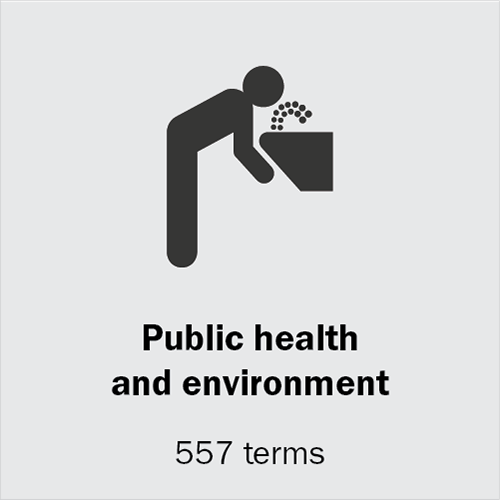
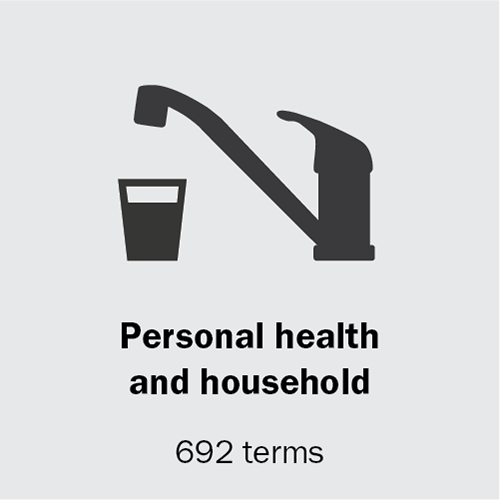
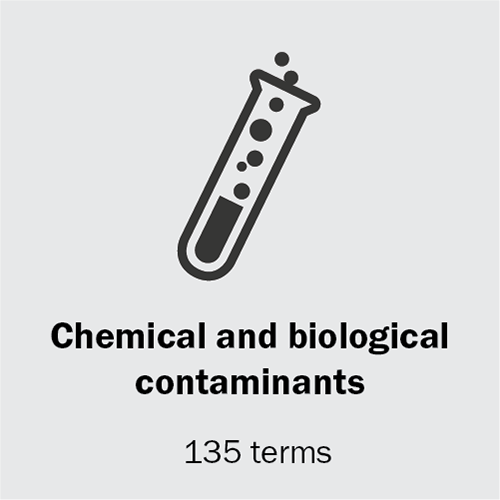
The Google Health API, which provides more granular data than the public Google Trends website or the Trends API, was launched in 2009 to help researchers detect patterns in searches around the flu. While no search engine can represent the queries of all Americans, a vast majority of online searchers use Google, and a number of researchers are experimenting with its use as a tool for understanding the public’s attitudes and behaviors.1
The central point of analysis for this study is search activity (also described as interest) per week for each of the five main search categories within each geographic area (the city of Flint as defined by its DMA, the state of Michigan and the U.S.) over time. Change in search activity is presented as percentage increases, which measure week-to-week change within one category and geographic area – for example, change in search interest in the Personal Health category across the state of Michigan. While there will always be small fluctuations in search activity, researchers identified periods where searches rose or fell in a meaningful way by using a combination of statistical techniques, generalized additive models and changepoint models. Of the 154 distinct time periods identified across search term categories and geographic areas, 24 registered measurable increases in search activity. Some of these were quick spikes (increases that took place over one or two weeks) while others were more gradual increases over the course of several weeks.
It is important to keep in mind that Google only makes its search results available in the form of proportions of all searches in a geographic area, rather than as a raw number of searches. For example, all searches within Flint that fall under the category of News and Media are shown as a proportion of all searches overall, on any topic, that week by users in Flint. (If the proportion of searches for a term or group of terms is below a certain threshold, known as the privacy threshold, Google Health API returns a result of zero as a way to protect the privacy of individual users and to ensure that they cannot be identified.) The analysis thus measures whether that proportion has increased or decreased in a meaningful way between periods identified by the changepoint model. It is also important to note that the Google Health API provides proportions specific to each geographic area (i.e., the proportion of searches for a locally relevant topic are likely to be higher in that local area than across the entire U.S.). Thus, the meaningful measures are changes within a geographic area.
Finally, one could hypothesize that if the total number of searches is growing (either due to a big one-time event or just the natural growth of Google searches), then the number of searches related to a specific term or group of terms could potentially indicate an artificial change or stability (regardless of the raw number of searches related to a term). However, the number of Google searches is so large that, according to internal Google analysis, even big events have a relatively small effect on the total number of searches in a given day. Still, researchers took further steps to minimize any possible effect by using week-level data, drawing 50 samples for every search category each week in each geographic area, and by identifying meaningful changes using the changepoint method described in the methodology.
To supplement the analysis of Google search data, the project also includes an audit of news coverage produced by a sample of local, regional and national news media as well an analysis of all Twitter posts across the U.S. related to the crisis. This digital essay presents the data in many graphical ways, from trend lines representing the entire 2 ½-year time range to circular graphics that zoom in for details at the weekly level.
The analysis is divided into three distinct phases, mirroring the development of the crisis: 2014, when the contamination initially became public; 2015, when it became a significant local issue; and 2016, when it hit the national news and launched a federal government response.
2014
Apr 25 – Flint switches from Detroit to Flint River for tap water
Aug 16 – Flint issues boil water advisory due to detection of fecal coliform bacteria
Sep 5 – Flint city issues another advisory due to more positive tests for coliform bacteria
Oct 13 – General Motors stops using Flint river water in its factories
2015
Jan 2 – Flint issues warning that water contains high levels of toxic byproducts
Feb 3 – Gov. Snyder approves $2M for water system improvements
Feb 18 – High lead levels are found in the tap water of Flint resident LeeAnne Walters
Feb 25 – Walters contacts Miguel Del Toral, a manager at the EPA’s Midwest water division
Feb 27 – Del Toral emails aides at the EPA and the Michigan Department of Environmental Quality
Mar 3 – City tests find lead levels that are nearly 27 times the EPA action threshold in Walters’ tap water
Mar 27 – Blood tests reveal that all of Walters’ four children were exposed to lead and one of them has lead poisoning
May 6 – Tests reveal high lead levels in two more homes in Flint
Jun 5 – A group of clergy and activists file a lawsuit against the city
Jun 24 – Del Toral says in a memo that the absence of corrosion controls is a major concern
Jul 9 – Del Toral’s memo is leaked
August – Virginia Tech’s Mark Edwards and his students begin testing Flint’s water independently
Sep 2 – Edwards makes his findings public supporting the corrosiveness of Flint water
Sep 24 – High blood lead levels detected in Flint children
Sep 25 – Flint issues lead advisory
Oct 1 – Genesee County issues public health emergency due to high levels of lead
Oct 16 – City of Flint decided to reconnect to Detroit water system
Nov 16 – Class action lawsuit is announced against city and state officials on behalf of Flint residents
Dec 14 – State of emergency declared in Flint
2016
Jan 4 – State of emergency declared for all of Genesee County
Jan 5 – State of emergency declared in Michigan
Jan 12 – Governor activates Michigan’s National Guard to assist with water and filter distribution
Jan 16 – President Obama declares state of emergency in Flint, freeing up to $5M in federal aid
Mar 6 – Democratic presidential candidates hold a debate in Flint
Apr 20 – Three government workers charged with crimes for role in water crisis
May 4 – Obama travels to Flint and addresses residents
Jun 22 – Michigan Attorney General files lawsuits against companies for role in water crisis
Main findings
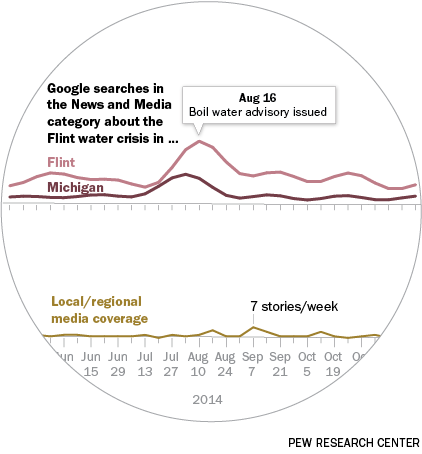
Even before the water crisis had started to unfold, residents of Flint had begun searching for information about their water at increased rates – largely preceding both government notice and heightened regional news coverage. In mid-July 2014, searches in the News and Media category related to water issues began to increase both within Flint and across the state of Michigan. By August, after a threefold increase in Michigan and a nearly fourfold one in Flint, they reached their second-highest peak in the whole 2 ½-year time range studied. This stretch of increased searches occurred weeks before the city of Flint issued its first boil advisory, on Aug. 16. It also occurred before regional news outlets audited for this report showed any substantial signs of elevated attention. Indeed, during these four weeks, the rate of coverage among these outlets was the same as it had been since the beginning of 2014 – just one or two stories per week. This suggests that information may have spread among local residents, largely before the news industry or local governments had turned increased attention to the issue.
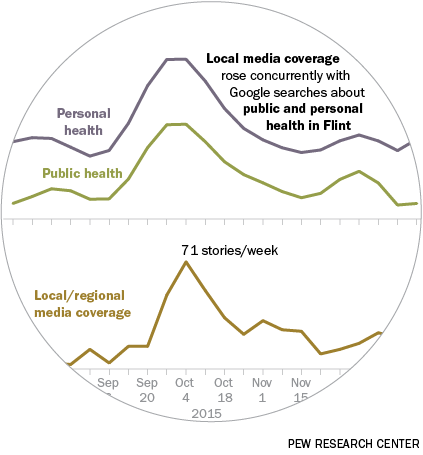
As more events occurred and news broke, the public reacted in real time by taking steps to gather more information. Of the 24 periods of heightened search activity identified across all categories and geographic areas, a large majority occurred at times roughly in line with major events in the water crisis. For instance, in September 2015, heightened search activity in Flint about personal and public health coincided with the city’s issuance of a lead warning on Sept. 25 and a public health emergency on Oct. 1. Over the five weeks surrounding those events, searches in the Personal Health category rose 154% and those in the Public Health category rose 380% compared with the week before the increase began. Additionally, periods of heightened search activity tended to occur when local and regional media coverage also increased. For example, during the five-week rise in search in September 2015, the media audit also identified heightened activity: 154 stories in total, up from 24 the five weeks prior. These data indicate that public search interest tends to align with key moments in the story and elevated news coverage. One limit to working with data at the week level, though, is the inability to get a more granular assessment – within one week, search could have increased a few days before news coverage or vice versa.
While most instances of increased search activity coincided with media attention and events, the opposite was not true: Heightened news coverage and developments in the story did not always translate to increased search activity. For instance, early in 2015, when Flint issued another warning about contaminated water (Jan. 2) and Michigan Gov. Rick Snyder approved $2 million in infrastructure improvements (Feb. 3), the news media covered the crisis at elevated levels (an average of 12 stories per week during eight weeks in January and February, compared with just one story per week in the eight weeks prior). However, this did not translate into any meaningful rise in search activity. Separately, in March 2015 high lead levels were found in the water of Flint resident LeeAnne Walters, and in June 2015 a group of clergy and activists filed lawsuits against the city. In these instances there again was no elevated search activity or rise in coverage or search. One possible explanation for the lack of heightened search activity during these instances is that, aside from the funding announcement, many of these events were incremental changes to existing storylines rather than major developments, such as later in the year when the state of emergency was declared, or in 2016 when the government advised residents to use only bottled water. These events did coincide with heightened search activity.
Search activity broadened each year, both in the mix of search categories and the geographic reach. In 2014, only three search categories related to the Flint water crisis showed signs of increased search activity, and only in Flint and Michigan: News and Media, Public Health, and Chemical and Biological Contaminants (though the Public Health and Contaminant increases were smaller). In 2015, search interest in the Public Health category grew, and Personal Health searches first saw a rise. Still, all the 2015 increases occurred over just two months’ time and were again confined to Flint and Michigan. It was finally in 2016, as the Flint water crisis came onto the national scene, that searches for all categories rose, this time across the entire country. We have seen in the past that public attention to issues begins at the local level and can take months or longer to reach national recognition. Similar to the Cliven Bundy standoff or tensions between police and the black community, this analysis shows that the Flint water crisis is another example of a local issue becoming a national one.
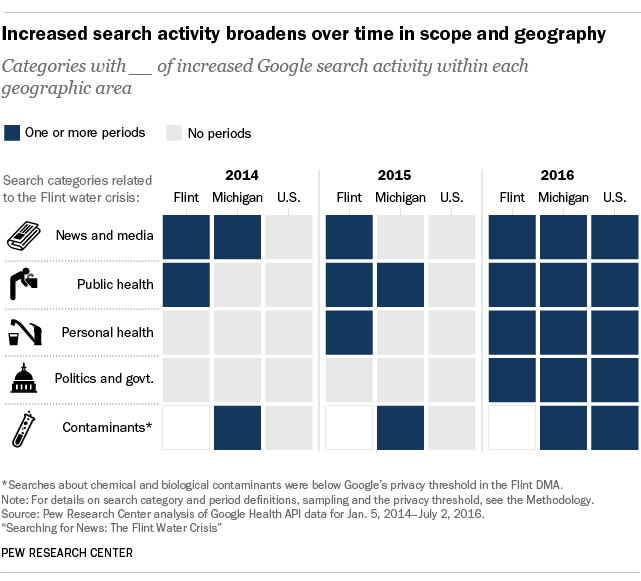
The trajectory of search interest across categories sheds light on how the public processes and reacts to public events. What the public searched for first, over the 2 ½ years, was news – the facts about what was happening – with searches such as “Flint water crisis articles” and “Flint water update” (in May and July-August 2014). Then, in 2015, the public began asking more about how the contaminated water would affect their own day-to-day living. Searches for both personal health-related items such as “lead water absorb skin” and public health queries such as “water pollution causes” grew steadily over a five-week time span in September and October, ultimately rising 154% and 380% respectively. In 2016, when the governor activated the National Guard and President Obama announced $5 million in aid, members of the public both locally and nationally began looking into the political aspects of the story.
Even though searches in the Personal Health category did not show any increased activity until 2015, they always accounted for the largest proportion of search activity in all geographic areas – speaking to the high baseline interest in personal health matters tied to water, even outside of the Flint story. There are likely at least two elements at play here. First, personal health issues such as bathing and whether to use tap water in baby formulas are subjects that members of the public are likely to search for regularly – whether there is a water contamination issue in the news or not. Thus, the baseline proportion for this type of search is higher than others. (A majority of the 692 search terms in the category do not specifically mention Flint, as not everyone would type that word into a search, especially those living there.) Second, past research about people’s news habits suggests that individuals often respond to news by thinking about how it might affect them directly. For example, when it comes to the economy, one of the topics people follow most closely is gas prices.
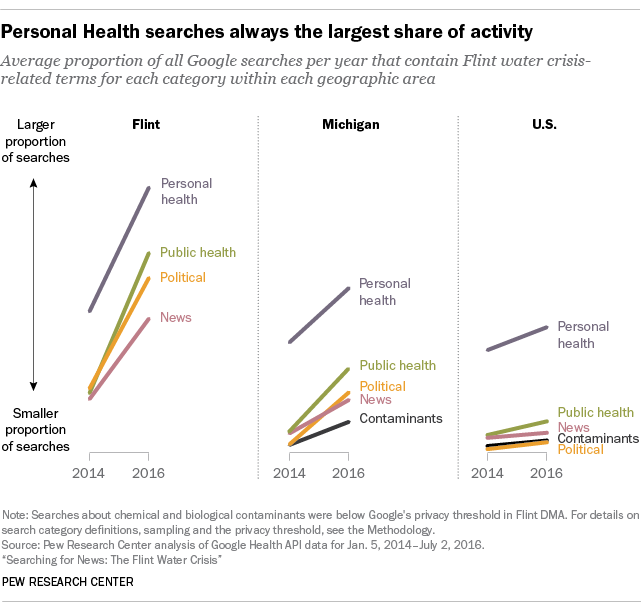
Twitter conversation about the Flint water crisis closely tracked national search activity. The number of tweets about the Flint water crisis remained minimal until 2016. During the week of Jan. 17, 2016 (the same week national search activity in all categories skyrocketed), tweets about the Flint water crisis nearly tripled compared with the week before, from about 140,000 tweets to more than 400,000 tweets. In total, there were about 7,000 tweets posted about the Flint water crisis in 2014, compared with about 92,000 in 2015 and about 2.1 million in the first half of 2016.
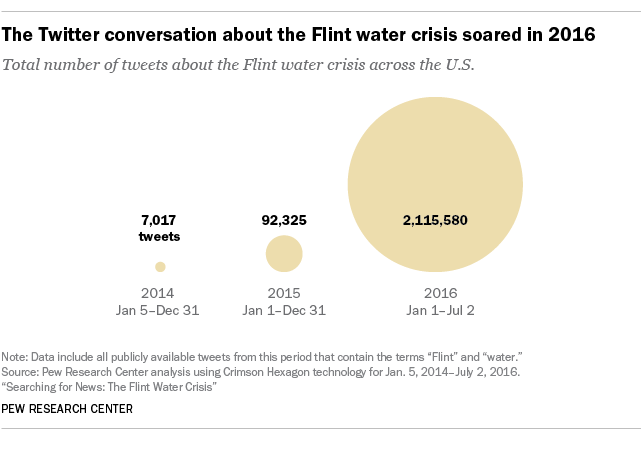
In addition to the findings about the water contamination in Flint, the study sheds light on what search data can and cannot tell us about public attitudes and behavior. Researchers spent months exploring, testing and validating the tool and data output before deciding upon the most appropriate method for this study. To help others understand the dynamics of the Google search data, as well as the differences between the Trends website and the private Health API used here, the methodology offers a detailed accounting of each step of that process and decisions made along the way. An accompanying blog post offers key lessons from a research perspective and a Q&A explains how the research was conducted.

The early days of the water crisis, January – December 2014
In Flint, and to some extent across the state, 2014 saw the beginnings of search interest in aspects of the water crisis. In particular, Flint residents were primarily searching for news of the water problems, and to a lesser degree, information about the public health impact of the crisis. Michigan residents more generally were also searching at higher rates for news of the crisis and, again to a smaller degree, for information on specific water contaminants. At the time, personal health and political aspects of the crisis had not popped. National search activity would not rise in any category until 2016. Twitter activity related to the crisis was also minimal throughout 2014.
Brief search chronology
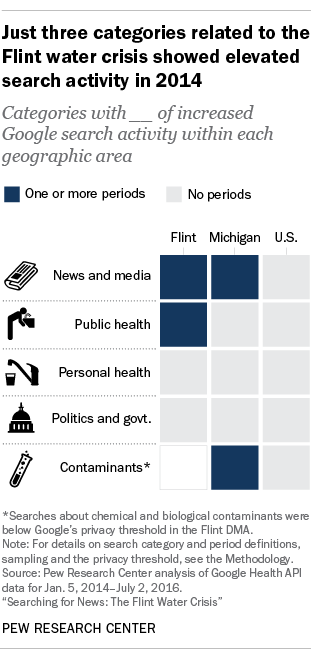
The first time Google search activity rose in relation to the Flint water crisis was in May 2014, in the News and Media category. These searches, with terms such as “Flint water crisis news” and “lead contamination USA Today,” rose for three straight weeks before falling back down. Search activity would not rise again until July and August – this time not only in Flint but also across Michigan, and to a much more substantial degree. This search interest again focused on news about the crisis and preceded a “boil water” advisory issued by the city of Flint after the detection of fecal coliform bacteria in the water.
Then, on Sept. 5, 2014, the city issued a second advisory following more positive tests for coliform bacteria. Concurrently (the week of Aug. 31), searches about public health terms such as “water pollution city” or “Flint water environment” registered a small uptick for the first time.
Also that week, searches in Michigan in the Contaminants category, including terms such as “water contamination coliform” and “water quality ppm,” started increasing. These searches continued to inch upward for eight consecutive weeks, finally peaking during the week starting Oct. 19, around the same time General Motors decided to stop using Flint River water at its engine plant because of high levels of chloride, which allegedly caused corrosion. Over the eight weeks of search activity growth, searches about contaminants increased by 161%. Even with that increase, however, it is important to note that the overall proportion of searches in the Contaminants category is far lower than those of other categories such as Public Health and News.
Demand among local residents for more news about what was happening not only rose before other categories but also preceded increased regional news coverage and government notices.About a month after the city of Flint switched its tap water supply from Detroit’s system (Lake Huron) to the Flint River in April 2014, Google searches for news about the Flint water crisis registered a first, moderate uptick in Flint. In the week of May 11, News and Media searches about Flint water issues increased 17% from the week before. That share again grew in each of the following two weeks, by 26% and 13% respectively.
News and Media searches in Flint remained somewhat elevated over the next seven weeks, but then a larger increase occurred both within Flint and across Michigan.
Searches increased at the state level first. In the week beginning July 13, 2014, search interest in Michigan related to news about the Flint crisis shot up 38% from the week prior. It then continued to grow through the week of Aug. 3, reaching the second-highest peak for News and Media searches in Michigan over the entire 2 ½-year time range, second only to when Obama declared a national state of emergency in January 2016. Over the four weeks of continuous increases, searches about news on the water crisis in Michigan experienced a threefold increase before returning to pre-peak levels.
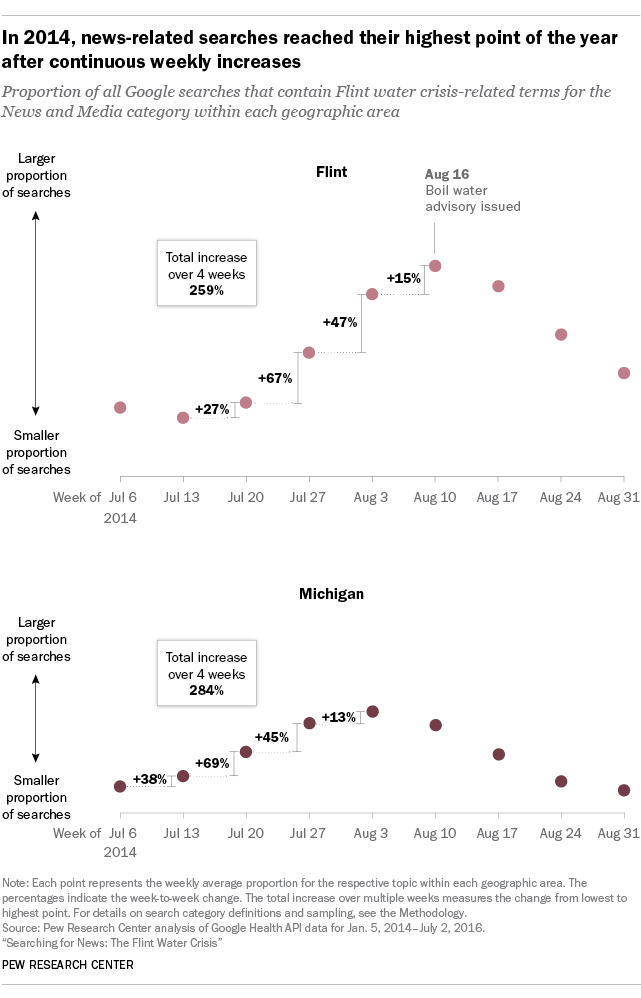
In the city of Flint, meanwhile, searches for news about the crisis began to rise again a week later than in Michigan (July 20). Within this more heavily impacted geographic area, searches rose 27% over the previous week and continued to increase for the next three weeks (adding 67%, 47% and 15% each consecutive week), reaching their peak the week of Aug. 10. That was the same week fecal coliform bacteria were detected in Flint’s water, leading to the “boil water” advisory issued by the city on Aug. 16. Over the whole four-week time span, News and Media searches in the Flint area more than tripled from what they were before the rises began.

Both of these stretches of heightened News and Media searches occurred weeks before the advisory was published. In another sign that the public may have been ahead of the local government and news media, on July 30 – during the period of increased search activity – the city responded to citizen complaints about the color of the water by flushing out the city’s fire hydrants, but they did not test the water’s safety at that time. The first period of heightened search also preceded a rise in news media attention to the crisis. From May 25 through the week ending Aug. 16, the media audit data show no rise in regional news coverage. Across these 12 weeks there were never more than two stories per week in the outlets audited, and an average of one per week.2 During the week following the boil advisory, on the other hand, local and regional news media attention grew, with a total of five stories that week among the outlets studied.
It is worth noting that, separate from health-related coverage, there were two weeks – April 13 through April 26 – when one media outlet in particular gave increased attention to the switch itself and how the costs might trickle down to local residents (there were 14 stories identified during these two weeks). But this was not sustained and was not about the water itself or any health issues, as was the case for the News and Media search category (with terms such as “drinking water crisis news” and “lead poisoning news”).3
Later in 2014, however, the first increase in search activity related to public health elements of the crisis coincided with government activity and a small uptick in local and regional media coverage. On Sept. 5, another advisory was issued, following more positive tests for coliform bacteria. During that same week, searches in Flint under the Public Health category increased 6% from the week before and continued to grow through the next two weeks. Over the three weeks, search interest in public health grew 25%. Local and regional news media also turned to the issue at slightly higher rates, producing 11 stories in the first two full weeks of September, up from just two during the two weeks prior.
Still, all these periods of heightened search activity in 2014 would not surpass the search levels in 2015 and 2016. Even though searches in the News and Media category in Flint reached, in August 2014, their second-highest point of the entire time range studied, the average search activity for this category was still lower overall in 2014 than in the other two phases. Proportionally, there were 18% more news searches per week in Flint 2015, on average, and 150% more in 2016. As with the News and Media category, Public Health searches would register much higher levels after 2014. Even though the week of Sept. 14, 2014, marked a notable rise in search activity related to Flint public health information, search interest for this category was relatively small compared with the two later phases (27% more Public Health searches in 2015 than in 2014, on average, and 235% more in first half of 2016 than in 2014).

Local and regional interest broadens, January-December 2015
In 2015, Google searches by users in the Flint area moved beyond the unfolding facts of the news story itself to how the events were impacting their own lives. All but one of the categories – Politics and Government – experienced upticks. Still, all the increases occurred over a two-month time range and were again only in Flint and Michigan. National search interest and Twitter activity remained relatively flat over the course of 2015.
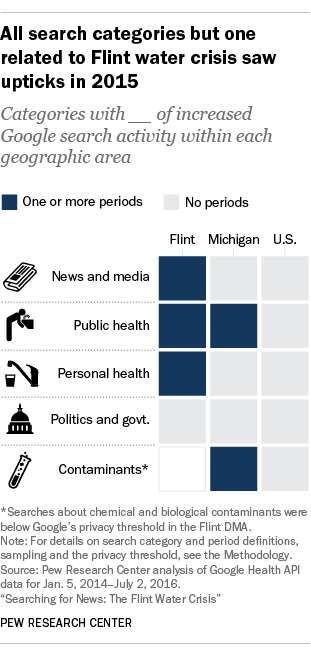
Brief search chronology
In 2015, the first notable instance of elevated search activity occurred in September. Google users in Flint searched for news about the crisis at heightened levels the week of Sept. 6, up 9% from the week before. Search interest continued to climb for another three weeks.
During that same first week in September, Flint residents also began connecting the crisis more directly to their own lives, with increased search activity in the Personal Health and Public Health categories. Searches related to personal health sustained heightened activity for a week longer than searches for news, hitting their second-highest point in the entire 2 ½-year time range.
Searches in the Public Health category also increased at the state level from the week starting on Sept. 6 through the week of Sept. 27 (a 268% rise over four weeks). Also during that time period, users across Michigan displayed a second round of elevated interest in learning more about the chemical and biological elements, though as in the first phase, the overall proportion of searches for this category remained below all others in Michigan).
In early fall 2015, as more became known about the severity of the water contamination, residents in both Flint and across Michigan began searching intently about the personal and public health implications. Signs of increased activity in Flint began the week starting Sept. 6, when searches related to personal health issues such as “Flint water bathing” and “tap water cloudy” grew 9% over the previous week and searches in the Public Health category such as “water pollution agriculture” and “lead test school” grew 2%. These were followed by continuous increases through the week starting on Oct. 4. Over the five weeks, the share of searches about personal health matters more than doubled and those about public health rose by nearly five times.
In addition, searches in Michigan under the Public Health category also experienced an increase from the week of Sept. 6 through the week of Sept. 27 (the proportion of searches more than tripled over these four weeks).
These five weeks of increased search activity coincided with a series of public reports and government actions that shed more light on the extent of the contamination, the individuals affected and the additional steps local residents needed to take. On Sept. 2, Marc Edwards, a researcher from Virginia Tech, released the results of tests he conducted on Flint water samples in which lead was found. This was followed by the results of tests conducted by Dr. Mona Hanna-Attisha, a pediatrician, who found that the number of children with elevated levels of lead in their bloodstream had doubled since the water source was switched in April 2014. In response, on Sept. 25, the city of Flint issued a lead warning and on Oct. 1 Genesee County declared a public health emergency.
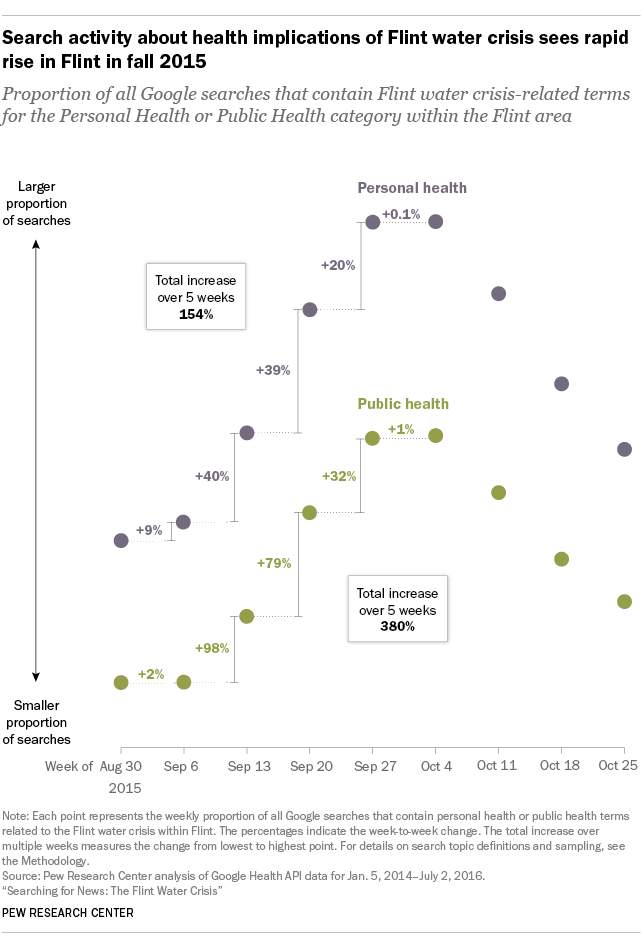
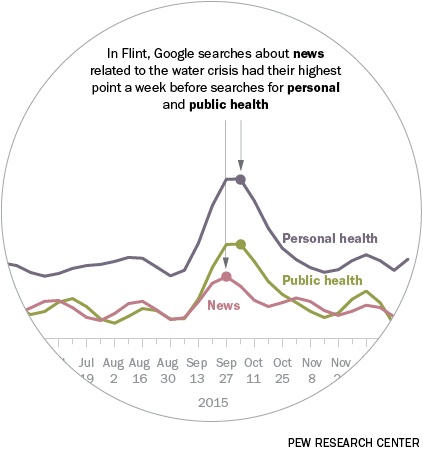
Google searches in Flint for news related to the events also rose during this time period, up 9% the week of Sept. 6 and 76% the next week. They reached their high point the week of Sept. 27, for a total increase of 223% over the four-week time span. Even as events persisted and the county issued its emergency advisory, however, searches for news began to fall back, while those related to public or personal health continued to rise for another week.
Increased search activity in Flint coincided not only with events but also with heightened local and regional media coverage. In 2015, from the week starting Sept. 6 through the week beginning Oct. 4, researchers identified 154 news stories produced by the local and regional outlets audited. That compares with a total of 207 stories that were identified for all of 2015 prior to this point (week of Jan. 4 though week of Aug. 30). By contrast, national coverage remained largely flat throughout the year, with a small uptick from the week of Sept. 27 through the week starting Oct. 4; there were 10 stories identified in total over this two-week time range, up from virtually none since the beginning of 2015.

The news coverage coincided very closely with the sharp boost in public desire to learn more about their own personal health and the state of health in their communities. In contrast with previous months, local and regional coverage in this instance remained elevated for a bit longer than public search interest. Even though search activity in public and personal health began to fall back down the week of Oct. 11, the local and regional media’s attention to the issue remained somewhat higher through much of November. Local and regional media outlets produced another 192 stories from the week of Oct. 11 through the week of Nov. 15.
A number of events in 2015 connected to the water crisis did not translate to any meaningful rise in search activity – even though some did receive media attention. On Jan. 2, for instance, the city published an advisory about too much disinfection byproduct in the water, and a heated City Hall meeting about the crisis was held on Jan. 21, followed seven days later by the distribution of bottled water in a giveaway program. In February, Gov. Snyder approved $2 million in infrastructure improvements, and in March the Environmental Protection Agency stepped in after Flint resident LeeAnne Walters’ son developed skin rashes; subsequent tests of her home’s tap water found high levels of lead.
During this time, however, not one of the five search categories studied showed any major signs of increased search activity in any of the geographic areas studied. This was the case even amid elevated local and regional news coverage through early February of that year, which gradually declined as spring began.

Water safety concerns register nationally, January-July 2016
If 2015 was when interest among Flint-area residents turned personal, the first half of 2016 was when interest in water safety and the dynamics of the story registered nationally. High-level national activity and intense media coverage related to Flint aligned closely with individuals at the local, state and national levels turning to Google at an increasing rate to learn more about the different elements of the water crisis.
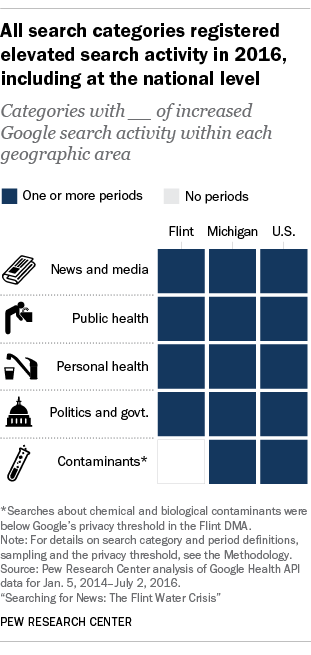
Brief search chronology
Public search interest grew dramatically in January 2016 across all aspects of the crisis, corresponding closely to significant events and heightened media coverage.
At the national level, searches about news and personal health issues showed some first small signs of increased activity the last week of December 2015, but it was in January 2016 that search activity really took off. From the week of Jan. 3 through the week of Jan. 24, searches for all five categories increased by up to 19 times what they were before.
Within Flint and across Michigan, the story was similar. In Flint, searches in all but the Contaminants category (data for this category were not available for Flint because the level of activity was below the privacy threshold required by Google) started increasing the week of Dec. 27, 2015, and also reached their highest points the week of Jan. 24. And across the state, the same pattern of growth was found in all five search categories.
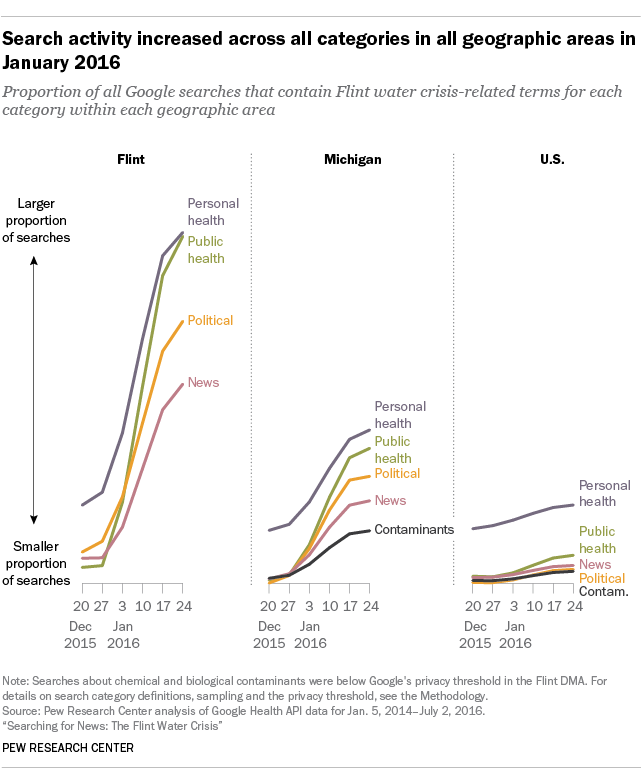
The involvement of the federal government in Flint’s water issues and the launch of national-level search activity coincided with accompanying national news coverage. On Dec. 14, 2015, a state of emergency was declared in Flint, followed about three weeks later by another state of emergency for Genesee County (containing Flint and the larger Flint DMA) and the state of Michigan (Jan. 4-5, 2016). A week later (Jan. 12), the governor activated the Michigan National Guard to help distribute filters and bottled water, and, on Jan. 16, President Obama declared a state of emergency, freeing up to $5 million in aid and assistance from the Federal Emergency Management Agency. That same week (Jan. 10-16), local and regional news stories more than doubled from the week before: A total of 129 pieces were produced in the local and regional news media studied, compared with 55 the week prior. News stories found in national media studied here more than tripled during the same week from the week prior.
It is important to note that the total number of Flint-related news stories identified in national as well as in local and regional news media was much larger in 2016 than in the two years before, even though only half the year was studied in 2016. More than four times as many stories were found in local and regional coverage in 2016 as in the previous year (from 668 news stories audited in 2015 to nearly 3,000 stories in 2016). National media also experienced dramatic increases in 2016. For these first six months of 2016, researchers identified a total of 749 news stories in national media coverage about the Flint water crisis, up from 25 stories the year before. Coverage at both the national and regional levels did ebb and flow over these six months, often spiking when events occurred and lessening soon after – though it maintained a somewhat higher baseline of coverage than in 2014 or 2015.
The search data suggest that events in one region could spur people outside of that region to see whether similar events could affect them. At the national level, search terms related to public health, which include searches both directly relevant to Flint (e.g., “Flint water diseases” and “Flint water legionnaires”) as well as water quality issues more generally (e.g., “lead water health effects” and “lead water limit”) started rising in the week of Jan. 3 – up 60% from the week before. These searches continued to rise, reaching their peak the week of Jan. 24. In total, public health-related searches more than quadrupled over these four weeks. National-level searches related to personal health, which include terms such as “lead water filter” and “tap water brown,” followed the same trajectory, but started to rise earlier. On the week of Dec. 20, Personal Health searches rose a minimal 2% from the week before, also reaching their highest point in the week of Jan. 24 after continuous weekly increases, for a total of 46% growth over those six weeks.
In early 2016, the angle of the story that saw the most dramatic rise in search activity was political; until then, this search category had seen no increases in any region. During 2014 and 2015, search interest for political terms such as “Flint water bill Congress,” “water pollution legislation” and “Flint water Obama” did not register any heightened search interest in any of the geographic areas studied, but in January 2016, the proportion of searches under the Politics category climbed sharply. In Flint and across Michigan, politics-related searches started to rise a week earlier than they did across the entire country. In Flint, on the week of Dec. 27, 2015, these searches increased 34% from the week before, then continued to rise for another four consecutive weeks. Overall, interest in political searches in Flint grew by 522% over these six weeks. In Michigan, the pattern was the same. Political searches began to increase statewide the same week they did in Flint, also growing for five continuous weeks. These increases occurred about two weeks after Flint declared a state of emergency (Dec. 14) and around the same time that a state of emergency was issued in Genesee County and across the state (Jan. 4-5, 2016).
As key political actors and the federal government became publicly involved in the Flint water crisis, political searches at the national level also came to the fore, posting a 363% growth the week of Jan. 3 from the week before. The proportion of searches continued to grow by 139%, 52% and 10% in the following three weeks. In total, political searches at the national level grew to 19 times from what they were prior to Jan. 3.
Even though all categories of Google searches about the Flint crisis reached their apex in January 2016, search interest continued at elevated levels through the end of the study, with smaller increases at key moments. Even after the January peak, the average activity across all categories and geographic areas remained higher than the averages in 2015. Averages from Jan. 31-July 2, 2016, ranged between 17% and 323% higher than averages for all of 2015, depending on the search category. At the same time, there were also smaller spikes in search activity, often tied to major events in the story, especially in the Politics search category. For instance, in the week starting March 6, 2016 – the week of the Democratic presidential primary debate in Flint, which addressed the water crisis – national searches for political terms rose 19% from the week before. Similarly, political searches in Michigan registered a 31% uptick that week over the week prior, and in Flint, the week-by-week increase was 20%. A similar bump upward occurred around the week the first criminal charges were filed (April 20), suggesting continued interest in the political outlook of the water crisis.
Conversation on Twitter about the Flint water crisis also exploded in January 2016. Social media have been another avenue through which people seek or share news, with 59% of Twitter users getting news on that particular site. Tweets about the Flint water crisis increased dramatically in January 2016; from the week of Jan. 10 through the week of Jan. 24, there were about 877,000 related tweets, up from about 58,000 the three weeks prior. By comparison, there were a total of about 7,000 tweets posted about the Flint water crisis in 2014, compared with about 92,000 in 2015 and about 2.1 million in the first half of 2016. Looking at the rate Twitter users were tweeting about the Flint water crisis, the weekly average number of tweets in the first half of 2016 skyrocketed compared with the weekly averages of 2014 and 2015: The weekly average number of tweets in 2014 was 139; it was 1,787 in 2015; and in the first half of 2016 it was 81,338. Moreover, the Twitter conversation remained elevated for a couple of weeks following the events in January before dropping off. As with search activity, interest on Twitter was renewed the week of the Democratic debate in Flint (nearly 127,000 tweets) and the week of April 17, 2016 (about 92,000 tweets), when criminal charges were filed against a Flint city official and two state workers tasked with monitoring water quality. Still, this resurgence of Twitter activity during these two events was much smaller than the number of tweets in January 2016.
Methodological note
This first foray by the Center into the Google Health API was as much an exploration of how analyses of search data can shed light on the public’s response to news and events as it was a study of the Flint water crisis. The detailed methodology is an effort to openly share what we learned through this process, and an accompanying blog post sums up some of the key methodological takeaways.
Acknowledgments
This report was made possible by The Pew Charitable Trusts. Pew Research Center is a subsidiary of The Pew Charitable Trusts, its primary funder. This report is a collaborative effort based on the input and analysis of a number of individuals and experts at Pew Research Center. Google’s data experts provided valuable input during the course of the project, from assistance in understanding the structure of the data to consultation on methodological decisions.
Timeline of key events






























